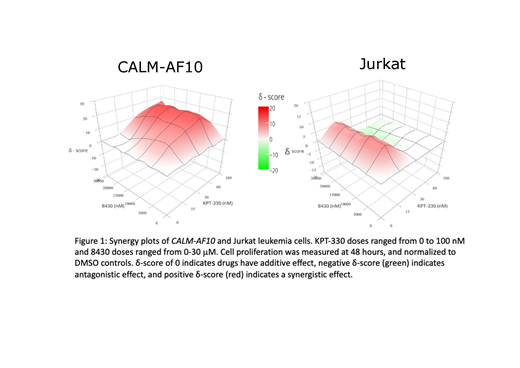Abstract
Background: The CALM-AF10 translocation is found in 5-10% of T-cell acute lymphoblastic leukemias (T-ALL), and a subset of acute myeloid leukemias (AML). CALM-AF10 leukemias are characterized by elevated expression of proleukemic HOXA genes. Since HOXA genes are difficult to target, we hypothesized that identification of non-HOXA CALM-AF10 effector genes could potentially yield novel therapeutic targets. To discover novel CALM-AF10-regulated genes, we took advantage of our prior observation that the nuclear export factor CRM1/XPO1 tethers CALM-AF10 to HOXA genes by interacting with a nuclear export signal within CALM. Using microarrays, we identified a set of genes that showed decreased expression in response to the CRM1 inhibitor Leptomycin B (LMB), similar to Hoxa genes, in murine CALM-AF10 leukemia cells. Then using RNA-sequencing, we discovered a set of genes increased in murine hematopoietic stem cells transduced with CALM-AF10. There were 11 genes that were both decreased in response to LMB and increased in response to CALM-AF10, which included the Hoxa gene cluster, as well as Six1. We demonstrated that CALM-AF10 increases Six1 expression and localizes to the Six1 locus, as it does the Hoxa genes. SIX1, like the Hoxa genes, is a homeobox gene that is associated with embryogenesis and is quiescent post-embryologically. In addition, SIX1 and its cofactor EYA2 are overexpressed in numerous solid tumors, and an inhibitor of the SIX1/EYA2 complex (Compound 8430) has recently been described. While there is evidence of a role for SIX1 in solid tumors, its role in leukemias has not been explored.
Objective: Evaluate the effect of a SIX1/EYA2 complex inhibitor on leukemia cell proliferation.
Design/Methods: SIX1 gene and protein expression were assessed in CALM-AF10, Jurkat (T-ALL) and NOMO1 (AML) leukemia cell lines via Western Blot and RT-qPCR. CALM-AF10 leukemias were derived from murine models in our lab, Jurkat and NOMO1 cell lines were obtained from ATCC. The effect of compound 8430 - an inhibitor of the Six1/Eya2 interaction - on cell proliferation was evaluated using Cell-Titer-Glo Assays and liquid culture proliferation assays. In addition, we used the the CRM1 Nuclear Export Inhibitor KPT-330 alone and in combination with 8430 in these cell lines. SynergyFinder2 (https://synergyfinder.fimm.fi/) was used to assess synergy of 8430 and KPT-330. δ-score is a calculated value that indicates synergistic drug interaction, with a higher δ-score indicative of a synergistic effect of the drugs.
Results: SIX1 gene and protein expression are increased in CALM-AF10 leukemia cell lines and Jurkat T-ALL cells, but not NOMO1 cells. Compound 8430 decreases cell proliferation in CALM-AF10 leukemias and Jurkat leukemia cell lines, however it did not affect the AML line NOMO1. Correspondingly, liquid cultures showed that 8430 alone slowed the proliferation of CALM-AF10 leukemia and the Jurkat cells, but not NOMO1 cells. The addition of KPT-330 to 8430 was synergistic in CALM-AF10 leukemia cells with a KPT-330 dose of 60 nM and multiple dose levels of 8430 (δ-scores 17-19) while in the Jurkat leukemia cells a dose of 30 nM of KPT-330 was synergistic at multiple dose levels of 8430 (δ-score 6-8) (Figure 1).
Conclusions: The SIX1 homeobox gene is highly expressed during development, and its expression is silenced post-embryogenesis. Through an initial unbiased screen, we discovered that Six1 may play a role in CALM-AF10 leukemogenesis. We have determined that Six1 expression is upregulated in the presence of CALM-AF10. A role for Six1 in CALM-AF10 leukemogenesis is further supported by the ability of a SIX1/EYA2 inhibitor to slow the proliferation of CALM-AF10 leukemia cells. Importantly, based on our observation that 8430 slows proliferation of Jurkat cells, SIX1 inhibition may be relevant in other leukemias. Finally, our demonstration that 8430 synergizes with KPT-330, a Nuclear Export Inhibitor, suggests the possibility of a novel therapeutic approach for CALM-AF10 and other leukemias.
No relevant conflicts of interest to declare.


